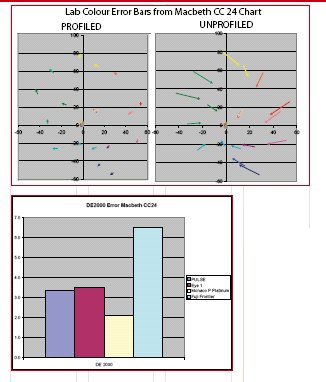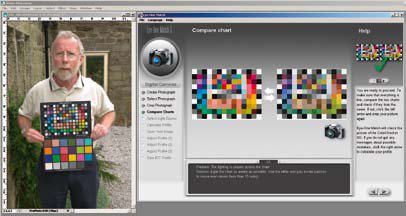articles/Digital/gretagmacbetheye-page2
GretagMacbeth Eye 1 XT - part 2 of 1 2 3 4
by Mike McNamee Published 01/09/2005

The Lab error plots for the colour values shows tiny bars for the profiled data and long bars for an unprofiled Fuji Frontier 570. This finding is also confirmed in the histogram on the left.
The Results We wanted to compare the profile-building performance of Eye 1 to that of its nearest competitor, the Pulse. In addition we exploited our experience of many hundreds of profile builds with the high-end MonacoProfiler 4.7.2 Platinum edition. We took great care to harmonise the build and test conditions and audited the performance using our bespoke computer code in conjunction with the high-end X-Rite DTP 41 spectrophotometer.
For the record, the variation across readings, with our calibrated instrument, is measured in 1/100ths of a point, any performance variations we report are real! We used an Epson 4000 printer with PhotoBlack ink and Epson semimatte proofing paper. Profiles were built with each set of equipment and then used to print the audit target for analysis.
Visual The audit targets were assessed in a controlled D65 viewing booth. We were looking for differences in the rendering of colours, the observed neutrality of the grey tone scale and the smoothness of the tones running into the highlights. It was impossible to decide which print was which visually, although there were some subtle differences apparent by carefully comparing one against the other. The highlights of the Eye 1 profile tapered more abruptly in the last 8 RGB points as the tone ramp ran into the 255 point. For all practical purposes the test prints from the two images were identical.
Measurements and Statistics The statistics were more noteworthy for their closeness than any detectable differences. The average error expressed as Delta E 2000 was 3.50 for the Eye 1 and 3.34 for Pulse. This compares with an average for all quality profile builds with the UltraChrome ink set of 3.30 and a best ever value of 2.09. This latter value was achieved by careful (3 hours work!) tuning of a start profile made with MonacoProfiler. At these levels of precision, there are larger differences between measurements made at D65 or D50. For all practical purposes, the statistics for both the Pulse and the Eye 1 are identical.
There were no significant differences in the maximum blacks of the targets (3/100ths of a percentage point) or the greyscale tonality - both profiles blocked the shadows out at about 20 RGB points.

The most startling difference occurs between profiled and unprofiled output. In a magazine issue devoted to quality it is worth emphasising the point. The histogram shows the total errors across the Macbeth chart. The unprofiled Frontier 570 error amounts to almost double the error compared to either profiled audit. This is not a new finding but worth emphasising - for best quality you have to be profiled!
Camera Profiling Eye 1 XT is provided with camera profiling software and the pack includes a GretagMacbeth SG as reviewed in the early part of this quality feature. There is little to add to what has been written there. In use the camera profiling is wizard driven and by far the most difficult part of the operation is getting the target evenly illuminated. Real lighting situations are effectively ruled out especially if any modelling light is applied. We found that Eye 1 cut in with a warning, initially that the black was too dark and then that the variation across the target was too great (more than 15 RGB points).
This was for a shot taken under 100% cloud cover which we might reasonably expect to be even! Opening and adjusting the RAW file using the 6 greys of the Macbeth Chart to refine the contrast range produced a good looking image from the slightly over exposed pair of the bracketed frames. The Eye 1 then accepted the white (after one further adjustment to slice 1/10th of a stop off the exposure level)) but still rejected the evenness of target illumination even though it only measured 7 RGB points difference from one side to the other. At this point we decided to override the objections and built a profile.
During this process you are offered options to adjust the contrast, exposure, saturation, shadows and highlights - we opted for leaving these on zero adjustment. When the new profile was assigned to the original it produced a Macbeth skin swatch with Lab values of 64, 13, 17 compared to aim values of 66, 14, 17 - an error of just 2 ΔE.
Overall the considered view on camera profiling changed during the course of reviewing this software and also the new Adobe CD2 RAW handler. Whilst the profile produced great accuracy, we had to do most of the work in Adobe RAW ahead of profile build and the result was good at that stage. If you normally "tweak" your images to taste, you might care to leave it at that. However, for accurate product photography the ability to pin down colours with great precision is well worth the additional effort required to use the profile building.
Monitor Profiling This was straightforward. We had no way of determing the precision of the calibration, normally spectrophotometers are less favoured than colourimeters for monitors, indeed GretagMacbeth supplies such a device separately - Eye 1 Display.
Please Note:
There is more than one page for this Article.
You are currently on page 2
- GretagMacbeth Eye 1 XT page 1
- GretagMacbeth Eye 1 XT page 2
- GretagMacbeth Eye 1 XT page 3
- GretagMacbeth Eye 1 XT page 4
1st Published 01/09/2005
last update 09/12/2022 14:54:50
More Digital Articles
There are 21 days to get ready for The Society of Photographers Convention and Trade Show at The Novotel London West, Hammersmith ...
which starts on Wednesday 14th January 2026





